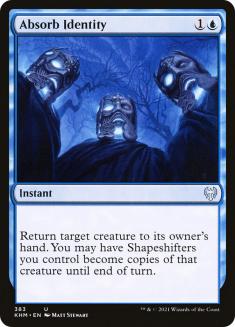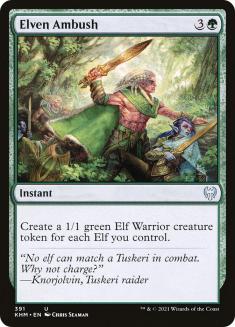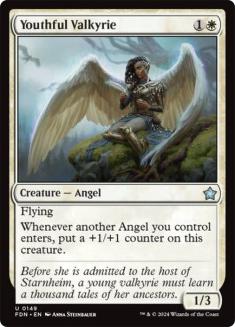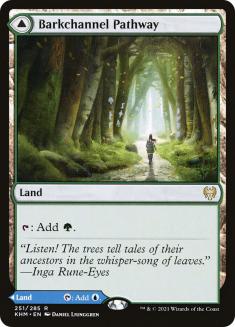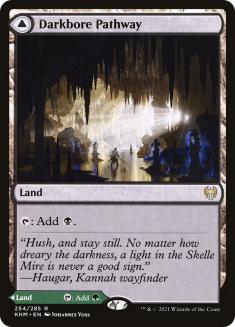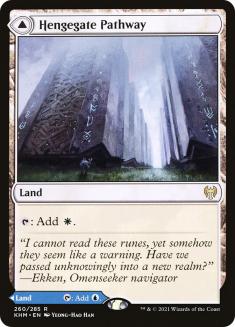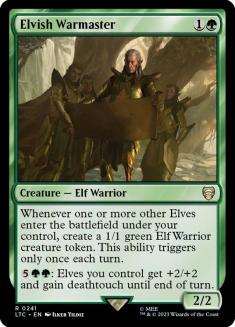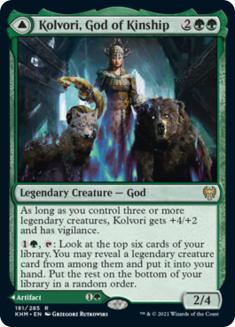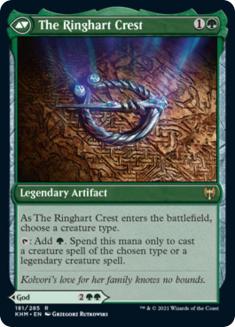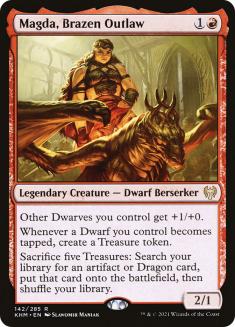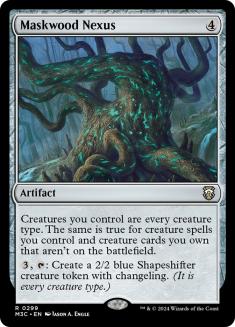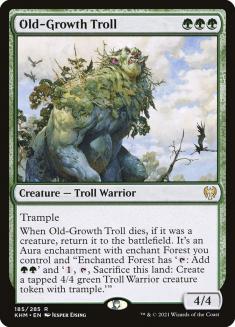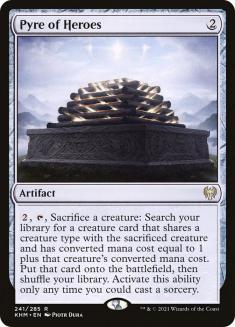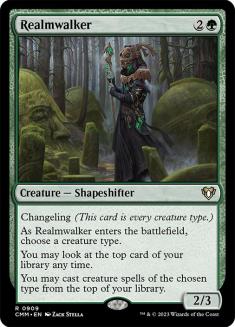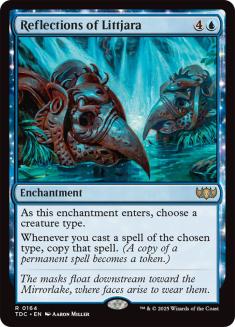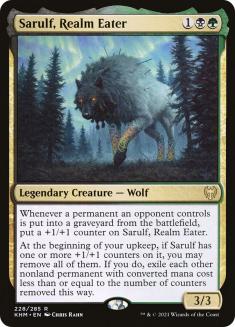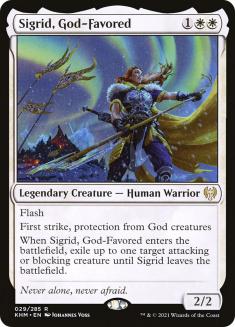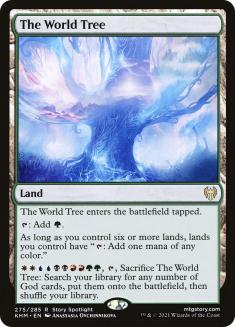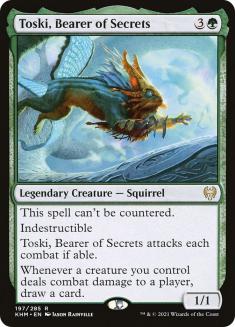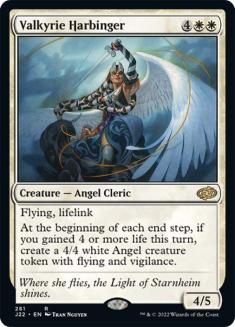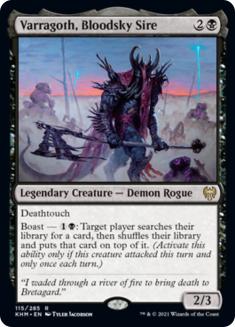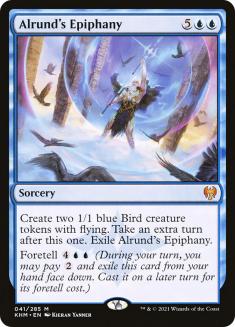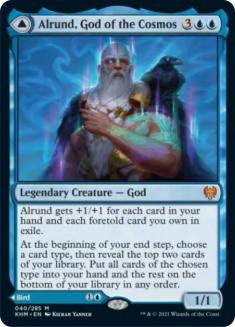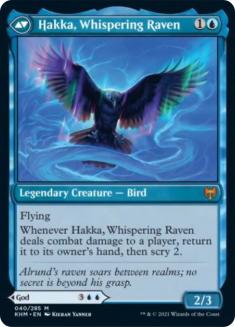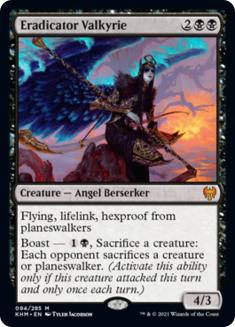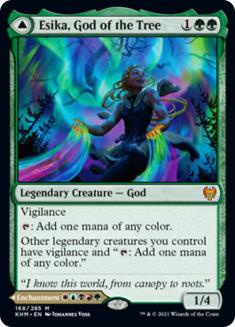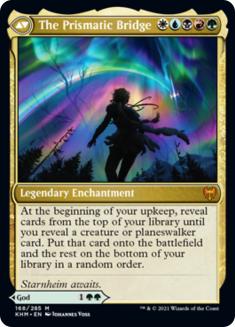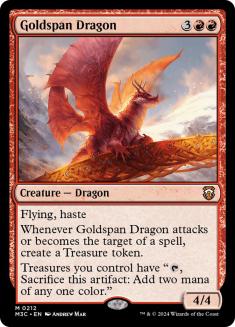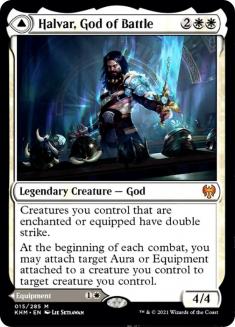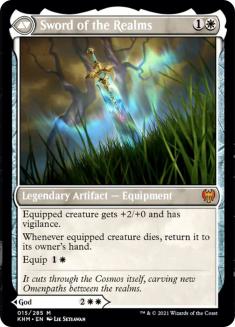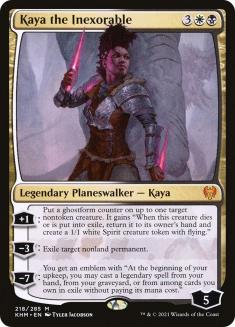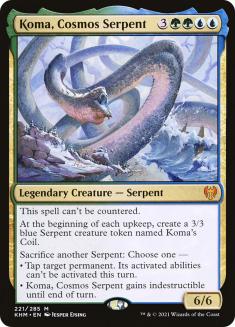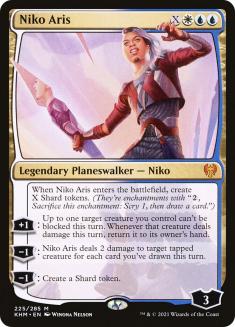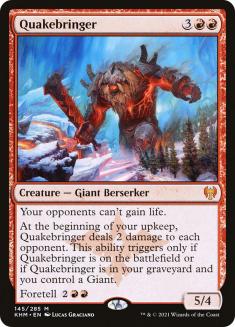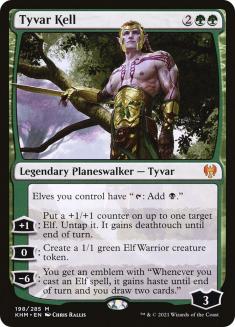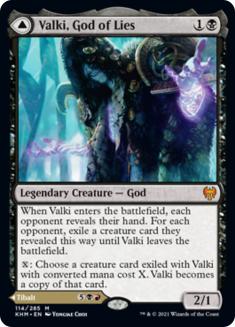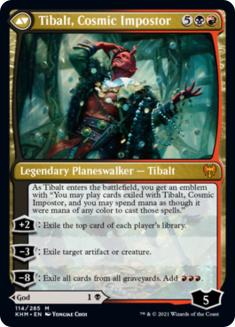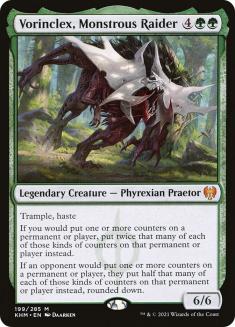Hey everyone! It’s been a while since I’ve written a Financial Values article for Star City Games. In fact, it’s been five years since my last one covering Kaladesh. I’ll get to all the fun analysis of card values for the Kaldheim cards previewed so far shortly, but allow me the time to make introductions.
My name is Ben Bleiweiss and I’m the General Manager of Sales for Star City Games. I’ve been playing Magic since 1994 and I’ve been involved in the financial end of the game for nearly as long! (I was in charge of pricing for the late and great Neutral Ground for a bit.) I joined SCG in 2003 as a full-time employee, with my focus on buying, selling, and pricing Magic cards. Since then, the company has grown from seven employees to 100+ employees. We have a team of people who are involved in pricing cards at this point.
The person who is primarily responsible for preorder pricing on Standard-legal sets is Jake Humphries, and we’ve worked together to come up with a comprehensive strategy for pricing our preorder cards.
- We try to price the cards to as close to post-release market as we can. In the past, preorder time used to be a time where everything sold for their highest values and then dropped precipitously. Over the past two years, we’ve moved away from this strategy and tried to price cards so that the price we’re selling them for is the lowest the card will be during the immediate preorder and post-release period. Obviously we can’t be right on this 100% of the time, but tracking has shown that our prices have had much, much less post-release volatility than it had in the past.
- Card values are driven primarily by Commander players at this point, and not by Standard / Pioneer / Modern / Legacy / Vintage players. This was beginning to become true pre-Covid, as Commander has become, by a wide margin, the most popular Constructed format in Magic. This means that, unlike in the past, cards have more value as individual entries to a deck — and less so as necessary playsets for tournament play. A card that may have been a singleton in Constructed in the past (like a top-end finisher) will have more value if it is also a must-include in Commander than a card that is a must-include four-of for Constructed but isn’t really seeing any Commander play.
- There are multiple variants of each card with every set release. Aside from the foil / non-foil versions of each card, there are now Extended Art / Alternate Frame / Extended Frame versions of every rare and mythic. There are various extra versions of these cards available in all other rarities as well for each set release. This means that we aren’t looking at a dichotomy of “What is the foil / non-foil value of this card?” When we look at Vorinclex, Monstrous Raider, we have to look at no less than six versions of the card at launch, instead of two.
- As a company, we also have a new Kaldheim Preview Gallery where we post all new cards as they’re previewed. This has nothing to do with the value of the cards in the set, but has everything to do with me wanting to show off the new shiny project that our Marketing and Technology teams put together!
I’m one of the first people (if not the first person) to do consistent financial values articles about Magic: The Gathering. In the past, I’ve had various ways and means of discussing the values of cards as they’re being previewed.
Let’s throw those all out.
Actually, let’s keep one thing. I’ve always stood by my analysis of card values being honest. I may be right, I may be wrong, but any valuation you’re getting from me is my genuine opinion on a card. I’m never going to try to sell you on a card that I think is bad just to make sales. That’s never been my modus operandi and I have fifteen-plus years of writing financial-value articles’ worth of history to hang my hat on. So if you see me writing a recommendation for a card, it’s one that I believe in, and likely one that Star City Games will be following up on as well.
Due to all the multiple variants of cards out there at this point, the average value of non-variant cards (both foil and non-foil) is lower than it’s been for a long time. Not counting outlier sets (like New Phyrexia as a high, or Dragon’s Maze as a low), the availability of more “bling” versions of cards has made the non-bling versions more affordable to the average player. Combine this with the lack of physical play in the majority of the world right now, and you have a supply / demand paradigm that favors the buyer, not the seller.
In talking about the values of cards in Kaldheim, I’d rather focus on why we have the cards starting at a certain price. Remember — our goal (Jake, me, SCG) is to price the cards so that they will start at a stable, no-rollercoaster-ride price. With this philosophy in mind, there are three main reasons why a card might go up or down in value significantly from their current value:
- Future previewed cards will make the currently previewed cards more (or less) valuable. As an extreme example, we have Steamflogger Boss. At the time it was previewed, nobody had any idea about contraptions. What would they do? Would they be supported? Without more information, evaluating Steamflogger Boss in a vacuum was nearly impossible. Point is — this card could go up, could go down — don’t know, need more info.
- We misvalued the card to begin with. And contrary to popular belief, we’ve been pricing stuff too low (and having it go up post-release) since we started our new preorder pricing philosophy, rather than the opposite.
- Supply shift. An example of this is the release of the 2020 Challenger Decks for MTG. Bonecrusher Giant is a heavily played Magic card, but it was also released in the Cavalcade Charge deck, and as a four-of in that deck. Because of this, dealers opened thousands of decks (and tens of thousands of Bonecrusher Giants), and an otherwise $3-$5 card is now at $1.50-$2 due to extraneous supply.
One last word — I’m going to have a future article that discusses the current glut of foil cards currently on the market. Suffice it to say that the foil non-variant versions of cards are worth significantly less than they were two years ago, thanks to the huge supply of foil cards put into the market through increasing the rate of appearance in Draft Boosters, including one per Set Booster and having eight to twelve foil cards included in each Collector Booster. Due to this, foil commons and uncommons especially do not have the value multiplier if they are Legacy / Vintage playable that they used to have.
Snow Lands
Currently $0.25 each (all common), there are twenty common snow lands in Kaldheim — five Snow-Covered basic lands, each with two pictures, and ten enters-the-battlefield-tapped snow two-color lands, each of which count as two basic land types (and therefore can be fetched). Here’s the price history of snow basics and related lands:
- Ice Age: Between $1 and $2 each.
- Coldsnap (five common basics, five uncommon enters-the-battlefield-tapped two-color lands): Between $0.75 and $1.25 each, non-foil. Between $6 and $20 each, foil.
- Modern Horizons (Full Art): Between $0.50 and $1.50 each, non-foil. Between $8 and $15 each, foil.
- Secret Lair (foil only): Between $10 and $25 each.
This brings us to Kaldheim. I expect both the regular basics and the two-color basics to follow similar trajectories to one another. These will be the most widely available snow lands ever printed for several reasons:
- There is one per Draft/Set/Collector Booster. The one guaranteed land in the Set booster has a 15% chance of being foil. The one guaranteed land in the Collector Booster will always be a foil regular Snow-Covered basic land, with additional chances for the two-color snow lands in the foil common slot (up to five per pack). Ice Age and Coldsnap snow lands were inserted in the place of commons (and were not guaranteed one per pack). Modern Horizons were guaranteed one per pack but packs of Modern Horizons were more expensive than packs of Kaldheim.
- There are going to be a lot more foil basic snow lands from Kaldheim than any previous set. Aside from the Secret Lair Snow-Covered basics, there haven’t been any guaranteed snow foils in previous set releases. The proliferation of Collector Boosters is going to change this paradigm.
- There’s going to be more Kaldheim opened than Ice Age, Coldsnap, or Modern Horizons. Kaldheim will add many, many more Snow-Covered basic lands to Magic’s ecosystem than the Secret Lair drop.
In the end, what does this mean? Traditionally, snow lands have been a safe bet to maintain or gain in value. This was especially true for the foil versions of snow lands. This set is going to change that trend, in the same way that Full-Art basic lands are no longer a shoo-in to have extra value. Like Full-Art basic lands, snow lands will have been done enough times (and had enough copies circulated) that they will no longer be special just for the sake of existing.
Does this mean you should get rid of all your Snow-Covered basics (and two-color snow lands) that are opened from Kaldheim? Over time, I’m sure these will all maintain and gain in value to some degree. People need twenty-plus copies of the regular snow basics for each deck if they care about playing snow lands to begin with. This means that, unlike other Commander cards, these will be in demand twenty-plus at a time versus the regular one-per-deck (at least for the snow basics, though not the two-color snow lands).
In the end, I think that these eventually will start going up in price, but “eventually” is a very broad term. My guess is nine to twelve months minimum before the regular versions of these cards appreciate past $0.25 each, and that the foil versions of these cards will start at $1-$3 each (and also stay there for nine to twelve months before the supply even thinks about drying up).
Commons
Due to the amount of product opened these days, it takes a lot for a common to go above bulk price. This is doubly so for foil versions of commons and uncommons, thanks to Collector Boosters. The only card we’ve priced above $0.15 is Village Rites, due to the value of the Core Set 2021 version of the card.
In the past, I would have said that the foil version of cards like Frost Bite and Ravenform would have a premium value. Again, supply will far exceed demand, so the foil versions of these cards will probably be in the $0.49-$0.75 range (whereas they may have been in the $1-$3 range pre-Collector Booster).
Uncommons
There are fifteen uncommons that are only available in Theme and Set Booster packs. They appear at about an equal rate to any other uncommon in Set Booster packs, making them no more or less rare than any other uncommon from this set. Technically they are slightly rarer because they do not appear in foil (so no appearance in Collector Boosters) and they do not appear in Draft Boosters.
Let’s take a brief moment to talk about Set Boosters versus Draft Boosters. Set Boosters were introduced with Zendikar Rising and were a smash success. The allocation at the distributor (and store) level for Set to Draft Boosters was heavily, heavily skewed towards Draft Boosters. This is understandable. Set Boosters were a new product and Wizards of the Coast (WotC) wouldn’t want to take a proven product (Draft Boosters) and cannibalize them for an uncertain product (Set Boosters).
Suffice it to say, Set Boosters were such an unqualified success that the ratio of production for Kaldheim has quickly reversed. I’d guess that between 75-80% of product at the distributor / store level are Set Boosters for this release and 20-25% are Draft Boosters. That means that for the sake of opening product, the difference in quantity of the “Theme / Set Booster-only” uncommons to regular uncommons is going to be negligible.
If we consider that a bulk uncommon is at $0.25-$0.49, here are the uncommons we feel rise about bulk value. All three of them are exclusives to Theme / Set Boosters.
Absorb Identity: $0.75
Unsummon + the potential to alpha strike is pretty strong. Also will be an auto-include in any Commander deck that cares about Shapeshifters or changelings.
Elven Ambush: $1
Elvish Promenade has been a solid $3-$4 card for over a decade. It’s been reprinted multiple times (Lorwyn, Duels of the Planeswalkers, Duel Decks: Elves vs. Goblins, and Duel Decks: Anthologies). There are two differences between Elven Ambush and Elvish Promenade:
- Elven Ambush is an instant and Elvish Promenade is a sorcery (making Elven Ambush better).
- Elvish Promenade is a tribal spell and Elven Ambush is not (making Elvish Promenade better).
In the end, the two are comparable enough that we feel confident in the value of Elven Ambush based on the value of Elvish Promenade.
Youthful Valkyrie: $1
Angels have always been one of the most popular tribes in Magic. Prior to this set, there have been exactly five non-changeling Angels that have had a mana cost of two or less: Angelic Curator (bad); Angelic Page (great in Limited, not really good for Constructed); Segovian Angel (decent for a tribal deck), Serra Avenger (which really couldn’t be deployed before Turn 4 without Aether Vial shenanigans); and Sustaining Spirit (which might as well not be an Angel).
Suffice it to say, Angel tribal decks are starved for early drops. They’re in even more need of drops that matter to the tribal theme. Youthful Valkyrie fits this role perfectly and is large enough (as a 1/3 flyer for two mana) that it could see some Constructed play if Angel tribal gets pushed hard enough in this set.
Rares
There are five rares that are Theme / Set Booster exclusives. Actually, scratch that — these can also appear in Collector Boosters (in the Saga / Theme Booster / Commander Deck slot). Again, these will be slightly rarer than any other rare (since they will not be in Draft Boosters), but will, for practical purposes, be identical in availability to any other rare in this set.
If we put bulk price at $0.50-$1.50, here are the rares we feel are going to be worth more than bulk!
The Pathways: $3 – $4
Once upon a time, the rare two-color lands for any given set were guaranteed chase cards for that set. This is probably one of the biggest casualties of Commander being the driver of card sales over more competitive formats. Playing a Simic deck? You only need one Barkchannel Pathway // Tidechannel Pathway, not the four that a Standard deck would need.
You also can’t effectively use the card unless both colors are in your Commander color identity. This is different from Standard, where you might run a Pathway to provide mana an off-color ability or spell.
We have a clear price history of Pathways from Zendikar Rising. There are six of them and their prices range from $3.50 to $6, with the average value of a Zendikar Rising Pathway is $4.25. We priced the Kaldheim Pathways at between $3 and $4 each, which is slightly lower than those from Zendikar Rising.
The price difference is solely a supply issue. There will be a huge supply of these available at release (due to everyone opening everything at once). Since there aren’t as many physical Magic events going on, there will not be a steady resupply into the market once the initial supply dries up. For this reason, I believe that these will likely go up $1-$2 each in about three to six months, solely based on a lessened supply versus a sustained demand. These are evergreen as far as demand goes, since their demand is based on Commander and not on Standard.
Canopy Tactician: $2.50
Available only in Theme Boosters, Canopy Tactician is both an Elf Lord and a Thran Dynamo — both of these are extremely attractive abilities to Commander players. Elves are also a major tribal component of Kaldheim, so this card also has dual applications in Standard Elf tribal decks and in ramp decks.
Elvish Warmaster: $2.50
Another card for Elf tribal decks. I can’t overstate how popular this tribe is, so having a playable card in that deck that feeds into the actual theme of the deck (making more Elves and making them bigger) means we’ve got a winner as far as demand goes.
Kolvori, God of Kinship // The Ringhart Crest: $2
The Ringhart Crest’s side of this card is more attractive than the Kolvori side. WotC doesn’t print many two-mana artifacts that produce mana these days, and the ones they do print usually enter the battlefield tapped. With that said, I think we shot a little high on this card and it should be more in the $1.50 range. The Gods in this set are thematically very different from previous Gods — they don’t recur or have indestructible — so the subtype isn’t going to carry the weight that it did in Theros and Amonkhet-style sets.
Magda, Brazen Outlaw: $2.50
When Magda was initially revealed, there was a run on Dwarven Recruiter from Odyssey. Dwarves have never been a very pushed tribe in Magic and Kaladesh block tried (and failed) to make Dwarves a thing. Magda pushes Dwarves in a much stronger direction. The first two abilities on this card are very strong for two mana, and the third ability is a great build-around as a commander.
We don’t know how the rest of the Dwarves in this set will look. We do know that the upcoming sets (Strixhaven and Forgotten Realms) have a lot of potential for expanding Dwarves as a tribe, so this card has a very good chance of going up in value based on the rule about future previewed cards.
Maskwood Nexus: $2
Speaking of Conspiracy / Arcane Adaptation, here we have a card that trumps both of those. Maskwood Nexus is playable in any deck (truly colorless), turns on any tribal interactions that your deck could support, and creates 2/2 creatures as well. Maskwood Nexus didn’t even need to have that last ability to be playable in Commander and the combo / synergy that it has with many decks is huge!
This is one of those cards that will stay in the $2 range for a while but will shoot up significantly once the supply dries up since it’s an artifact that can fundamentally change the way deck construction works. Other examples of this phenomenon, such as Mirror Gallery, Helm of the Host, Chromatic Lantern, and Panharmonicon, all have a long history of going up in value in the long-term. I believe Maskwood Nexus is a card that will follow suit with those other cards, given 6-9 months.
Old-Growth Troll: $3
Such a weird card. Three mana for a 4/4 trample is par for the course for a pushed green creature these days. What isn’t par is also having the creature turn into Wild Growth when it dies and then having it recur as a 4/4 creature a second time. I could see this slipping to $2 (due to having a GGG mana cost), or it could go up to $4 (because green ramp decks have been traditionally good the past two-plus years).
Pyre of Heroes: $4
We all know that Birthing Pod is a really, really good card. This card is cheaper than Birthing Pod on the front end (two colorless mana versus three colorless and one green Phyrexian mana). It costs more on the back end (two colorless mana versus one colorless and a green Phyrexian mana). It also is restricted to solely grabbing cards within a certain tribe. This makes it fantastic for Commander play because, let’s face it, there are a lot of tribal decks out there, but less useful for Constructed play where you’re looking more for a range of utility creatures or trying to combo into a win, and the combo pieces usually aren’t from the same tribe.
This is also the type of card that is a big winner in a Commander-driven economy. If this had been printed two years ago, the valuation of the card would have been pretty poor — “This is a bad Birthing Pod” — because the main comparisons would have been Modern-legal Pod decks. The valuation now is “this card is as-good or better than Birthing Pod in my *insert tribe here* deck!”, and it can be run in any color Commander deck (versus Birthing Pod, which was green-only).
I see definite room for growth on the value of Pyre of Heroes but it’ll take a few months for supply to dry up enough for the price to go up. I feel confident that this is a solid card for Commander that will hold value in the short-term.
Realmwalker: $4
First off, this fits into any tribal deck that runs green, due to being a changeling card. Second, we saw this ability on Vivien, Monsters’ Advocate recently. While this is more limited because you can only cast creatures of one type, remember that Realmwalker costs two less than Vivien, and if you’re playing a tribal deck, you’re likely going hit the creatures you want anyhow.
The only thing that will hurt the value of Realmwalker is card supply. It’s also the Buy-a-Box promo, so the value of all versions of Realmwalker will be suppressed to some degree due to extra availability. We’ve seen Buy-a-Box promos reach exceptional values in the past, but they generally have to be either functionally unique cards such as Nexus of Fate or so overwhelmingly powerful that they see play in multiple formats: Birds of Paradise, Supreme Verdict, Goblin Rabblemaster. Realmwalker is neither of those.
Reflections of Littjara: $4
It’s Doubling Season for nontoken creatures. This type of effect has always been super-popular with casual players. This card is a shoo-in slam dunk for Commander decks and will be extremely sought after post-release. It’s also causing people to take a look at Arcane Adaptation (which combos beautifully with this card). This is the type of card that will shoot up in value in nine to twelve months once supply dries up because it’s a unique effect that is easily splashable and fits into tons of deck themes.
Rules Note: Reflections of Littjara also doubles your tribal instants/sorceries, but you cannot change the target of that spell if the spell is targeted.
Sarulf, Realm Eater: $2.50
A build-around legendary creature for Commander and great midrange creature that doubles as efficient removal spell for Golgari decks, Sarulf is solid at $2.50 and may go up a little if Golgari decks take off in Kaldheim Standard. If you want Sarulf, I’d say pull the trigger since I don’t see it going down much from its current price.
Sigrid, God-Favored: $2.50
It’s not a secret that white is viewed as the weakest of the five colors in Magic at the present time. What should be more of a revelation is that this has been going on for what, seventeen years now?
Here are some articles I wrote in 2004 about the issues white had as a color:
I think this passage about sums up my thoughts on white:
I imagine the following exchange:
Silver Knight: “Quick, jump on my shoulders!“
Black Knight: “What shoulders?“
Whipcorder: “Come on guys, attack already!“
Savannah Lions: “Meow?“
(A Horde of Elves overruns White’s army of Babel) …
Look, we’re seventeen years past when I first wrote those articles and the fact remains that white is still the worst-received color in Magic. It’s still unclear what white does thematically that other colors cannot do, and white’s tribes are less popular than the tribes in other colors overall. Yes, Angels are popular, but so are Elves, Goblins, Zombies, Pirates, Dragons, Slivers, Vampires, Wizards, Merfolk, Eldrazi, Rats, Squirrels, and the such. I’d argue the only other popular white tribe right now is Humans and Humans appear plentifully in all five colors of Magic.
I’m going to have a future article dedicated to discussing the issues white has as a color but that brings me back around to Sigrid, God-Favored. We’ve seen three-mana pseudo-removal spells in white for years. This includes Oblivion Ring, Banishing Light, and Prison Realm. We’ve seen spells that kill attacking / blocking creatures in white at one-to-two mana for years as well. I just don’t see stapling that effect onto a 2/2 creature as something that will suddenly change the fortunes of white or make white more playable as a color.
If anything, I’d say this is worse than Banisher Priest, because at least Banisher Priest could proactively remove creatures. As such, I think this card is overvalued and will drop in price.
The World Tree: $4
This is a really, really good Commander card. If Temple of the False God is a staple, this is going to be a staple in any deck that runs all five colors. In addition, it’s an instant-win condition when paired with Arcane Adaptation, Conspiracy, or anything that shifts creature types to God.
In Standard, this is a shoo-in playable. It’s doubly-helped by WotC no longer pushing any lands to be legendary lands. Basically your opportunity cost of running this over a Forest (in any deck that runs two-plus colors) is the enters-the-battlefield-tapped clause. Even if you’re never going to activate the last ability, The World Tree will smooth your mana for any ramp or three-plus-color deck, meaning it’ll see a lot of play even as a one-of.
And yes, I’m bothered by something called “The” World Tree not being legendary.
The best comps I have to this card are the Castles from Throne of Eldraine (opportunity cost on mono-colored lands), Temple of the False God (which has been reprinted to oblivion), and Prismatic Omen. Once supply dries up, I see The World Tree going up in value.
Toski, Bearer of Secrets: $2.50
Technically this Squirrel is a plant for any future Squirrel-based cards that will see print. There’s nothing inherent to the card that demands it be played in a Squirrel deck, other than its own creature type. However, this is the first black-bordered legendary Squirrel — I’m never going to count changelings! — and for that reason it will be heavily sought after by players who really, really want to play a Squirrel commander deck.
In addition, the last ability on the card, “Whenever a creature you control deals combat damage to a player, draw a card.” is similar to Ohran Frostfang. The Frostfang is a solid $8 card and is one of the only highlights of the Commander 2019 decks. A four-mana indestructible creature is at least attractive to the same type of player that wants a five-mana 2/6 with this effect, though I’ll concede that the deathtouch clause on Ohran Frostfang probably makes it a stronger card (though dropping Toski a turn early with a bunch of mana creatures can get you card advantage much more quickly).
I think Toski will probably drop to the $2 range but is likely to stay there as long as it’s the only legendary Squirrel in Magic. It will go up in value if other black-bordered Squirrels start making appearances, but right now it still looks like that tribe will be under supported (or completely unsupported) through main set releases.
Valkyrie Harbinger: $2.50
The top-end of an Angel deck, though it is capable of self-sustaining its own replication (since the Harbinger itself has lifelink). I think that Valkyrie Harbinger is probably a little too high in price, as there are a lot of five-plus-mana Angels in Magic vying for slots in an Angel tribal deck for Commander and I don’t see this being viable in Standard.
Varragoth, Bloodsky Sire: $4
Varragoth is probably my pick for the most under-appreciated card in Kaldheim so far. It has many factors working in its favor:
- It’s a Rogue and Rogues are a popular tribe. In addition, I’m pretty positive that we’ll see Rogues as a supported tribe in the Forgotten Realms set and they’ve already gotten support from Zendikar Rising.
- It’s only a single black mana to cast. That makes it an easily splashable card in both Commander and competitive decks.
- The tutoring ability on this card is targeted. That makes this an extremely powerful diplomatic card for Commander. Think: “Let me hit you on purpose with Varragoth, and I’ll let you tutor up the card you most want to your deck.”
- For Constructed play, the trigger to tutor is simply attacking (and not actually dealing damage). This makes it extremely likely that Varragoth will let you tutor at least once, which is what you’re looking for. If it survives past one turn, chances are you’re going to win the game, since you decide every card you draw for the rest of the game.
- It’s got deathtouch. I find this to be completely unnecessary for this card to be good. It’s already good.
I don’t think we’ve ever seen a repeatable tutoring effect that A) is this cheap, B) has no real drawback, and C) can target multiple players before in Magic. Stuff like Planar Portal costs six mana and Maralen of the Mornsong comes with some major drawbacks. I think Varragoth is going to become a heavily played Commander staple (if not a heavily played commander, since it is legendary) and I see the price on Varragoth going up in the long-term once supply dries up (and significantly if Rogue tribal becomes top-tier post-Forgotten Realms).
Mythic Rares
Alrund’s Epiphany: $6
Taking an extra turn is the bane (or boon) of Commander players. I think this mechanic is the most divisive I’ve seen in that format — players either love or hate the idea of extra turns. Seven mana is pricy for a sorcery-speed Time Warp and the foretell cost merely brings it down to the territory of things like Walk the Aeons.
Comparable extra turn cards at six or seven mana include Karn’s Temporal Sundering (bulk); Nexus of Fate (instant-speed, recurring, promo only, $25); Part the Waterveil (bulk); Temporal Mastery (cheat cost at two mana, $6); and Walk the Aeons (can be cast multiple times, $7).
I personally think Alrund’s Epiphany is more Karn’s Temporal Sundering / Part The Waterveil, and less Temporal Mastery / Walk the Aeons. I don’t think putting two 1/1 flyers onto the battlefield is enough to make this card playable so I think the value on this card will go down some.
Alrund, God of the Cosmos // Hakka, Whispering Raven: $7
The front side of Alrund is pretty boilerplate for a five-mana legendary creature. It gets bigger based on hand / foretell size and it can draw zero to two cards at the end of your turn. This isn’t anything that we haven’t seen before: see Body of Knowledge; Overbeing of Myth; Aeon Chronicler; Psychosis Crawler; and Tishana, Voice of Thunder. Most of these listed cards have an above-average value due to the desirability of this mechanic, but none of them are superstars of casual play.
Does the two-mana side of the card make it more desirable? The answer is yes for one reason — you can do something productive in the early-game if you draw Alrund. At two mana, you end up with a 2/3 flying creature, which is a really good rate for a flyer even in today’s world of power creep. In addition, once Hakka, Whispering Raven hits, it goes back to your hand, so you can recast it as Alrund at a later time.
I think that because Alrund and Hakka is useful early-, mid-, and late-game, it’ll maintain value better than some of the previous iterations of this type of card.
Eradicator Valkyrie: $4
These days, four mana for a 4/3 flyer isn’t too impressive on its face. Lifelink and hexproof from planeswalkers are nifty, but neither of them really going to make me push Eradicator Valkyrie as playable. So instead, let’s look to the boast ability and the creature type.
Angels are going to be pretty pushed in this set. In an Orzhov-based Angels deck, this curves really nicely (since a lot of other Angels worth playing start mattering at around five mana, not four). The power of Eradicator Valkyrie is going to be mainly in whether or not it is an essential part of a tribal curve, more so than being played on its own in a black-based deck.
The boast ability is great in that you can activate it on the attack, but before blockers are declared. For two mana, you get a repeatable Diabolic Edict that can hit planeswalkers at times. I think this is more relevant to Commander play than Standard play, but two mana is an extremely pushed activation cost for this ability.
Esika, God of the Tree // The Prismatic Bridge: $10
On the front end, Esika is a Birds of Paradise that pushes a legendary tribal deck. It’s nice, but there are generally better options to play if you really care about mana-fixing or ramp. So instead let’s talk about the back side of the card.
Generally WUBRG spells are either highly desired, or complete trash. For every Sliver Queen or Maelstrom Nexus, there’s an Atogatog or Chromanticore. The Prismatic Bridge is going to be in the “more desired” category as deploying a free creature and/or planeswalker each of your turns is great and is a worthy payoff for a five-mana enchantment.
That’s not why it’s going to be heavily played though.
Current rulings say that DFCs interact with cascade in a perhaps unexpected way. From WotC Principle Editor, Matt Tabak:
In other words, Bloodbraid Elf can hit Esika, God of the Tree and then allow you to immediately put The Prismatic Bridge onto the battlefield for free! (Spoiler Alert: We’ll see this come up again with Valki, God of Lies.)
There have been other decks that have abused cascade’s interaction with cards in the past — see: Restore Balance, Living End, Hypergenesis — but this is another angle to allow cascade cards to see play in competitive Magic. This is doubly good if basically every creature you get for free for the rest of the game either costs three-plus or is another copy of Esika.
Goldspan Dragon: $12
Dragons are popular. Dragons that act as ramp spells are popular. Dragons that act as double ramp spells are going to be double-popular.
Okay, that’s not great analysis. Instead, let’s look at the history of mythic rare mono-red Dragons and their prices. There are sixteen and I’m not counting ones that have been printed at multiple rarities, such as Bogardan Hellkite or Ryusei, the Falling Star:
- Avaricious Dragon (ORI): $1
- Balefire Dragon (ISD, UMA): $20
- Hellkite Tyrant (GTC, C16): $18
- Furyborn Hellkite (M12): $3
- Hellkite Courser (CMR): $6
- Leyline Tyrant (ZNR): $3.50
- Mirrorwing Dragon (EMN): $2
- Moonveil Dragon (DKA): $2
- Scourge of the Throne (CNS/PWS): $15
- Skarrgan Hellkite (RNA): $1.50
- Stormbreath Dragon (THS): $1.50
- Terror of the Peaks (M21): $20
- Thundermaw Hellkite (IMA/M13): $6
- Utvara Hellkite (C16/GK1/C17): $6
- Verix Bladewing (DOM): $1.50
The fifteen prior to Goldspan Dragon have an average value of about $7 each. I believe that Goldspan Dragon is on the side of “good” mythic red Dragons and not the ones that end up at bulk. I also recognize that while they were Standard-legal, the price history of some of these Dragons was much, much higher. For instance, Thundermaw Hellkite stayed at around $15-$20 the entire time it was in Standard and Stormbreath Dragon was a solid $15-$25 card for most of 2013 and 2014.
The history of Standard-legal mythic Dragons says that a $10-$20 price tag is sustainable if the card sees heavy play. I believe that Goldspan Dragon is not as good as either Thundermaw Hellkite or Stormbreath Dragon were, but that still leaves it firmly in a safe range to support the current price tag.
Halvar, God of Battle // Sword of the Realms: $8
I don’t have a lot to say about Halvar (though Ross Merriam does!). There aren’t a lot of good comps for moving Equipment and Auras around like the front side does, but the back side gives a really, really good piece of Equipment. I believe the value in Halvar is probably more in the Equipment side than the God side and I also think Halvar will go down in value unless some extraordinary Equipment gets previewed soon.
Kaya the Inexorable: $7
Planeswalkers are no longer automatically $20 cards. This is good because when the expectation was that a planeswalker would automatically be a chase card, there was a lot of disappointment when card prices came crashing down post-release. We’re at the point where we can evaluate a planeswalker on its own merits, not just because of its card type.
Kaya is relatively strong as a planeswalker. The color combination for Kaya lends to what WotC is pushing for Angel decks (Orzhov). Having a free kill spell is great for those decks, because the +1 ability can lend to some really frustrating situations for an opponent. Bounce still gets around the ability to make a 1/1 Spirit, but killing a creature (no matter the method) will always leave you with a 1/1 blocker, preventing alpha strikes.
This also means I think it’s realistic to get to the -7 ability on Kaya and start getting free legendary spells for the rest of the game. This is an instance where you can safely activate a planeswalker’s ultimate at exactly the ultimate cost and not have to worry about losing the planeswalker long-term since you can the emblem to get Kaya back the next upkeep.
I think Kaya is very solid and this is a planeswalker I think that could go up in price from the current $7 value
Koma, Cosmos Serpent: $8
It’s not often that we get a creature that can make more creatures on every turn. Verdant Force is the most famous example of this type of creature and Koma is a clear upgrade over Verdant Force.
- Verdant Force: eight mana, 7/7. Makes a 1/1 each upkeep.
- Koma: seven mana, 6/6. Can’t be countered. Makes a 3/3 each upkeep, and can sacrifice those 3/3s to protect itself from removal or tap down opposing permanents (including lands!)
Koma is clearly playable in ramp decks and is going to be a headache to deal with in Standard and Commander formats. It may be vulnerable to bounce and exile effects, but it will also singlehandedly win a one-on-one game if it doesn’t die the second it comes down.
Niko Aris: $10
At three mana, Niko Aris isn’t a great planeswalker. The -1 abilities aren’t fantastic and the +1 ability is great for a blink deck (which admittedly is the right colors for Niko), but I don’t think it’s worth spending a card in your deck.
How valuable are Shard tokens? They’re better than Clue tokens by ability and Clue tokens were quite good in their heyday. At six mana, you’ve got three card draws (and scrys) along with whatever other abilities that Niko Aris has.
I still don’t think that this is on-rate for what most people want at this point, as there are better options to either draw cards or control the opponent’s battlefield. Unless I’m vastly underestimating the +1 ability to make things unblockable (and bouncing them), I think Niko is going to go down in value post-release.
Quakebringer: $4
I honestly think it’s too early to evaluate the worth of Quakebringer. Giants and Berserkers are two tribes that are going to be supported in this set, but it’s unclear how many early-drops these decks will get to push the themes. In particular, I can see a world where you get an early Giant on the battlefield and intentionally discard one (or more) Quakebringers to put your opponent on a quick clock with Tormenting Voice-type effects. Add in the “can’t gain life” clause (which is always popular in Commander) and I can see the potential for Quakebringer to be a Standard staple. Without those other Giants costing two to four mana, Quakebringer will be a bulk mythic.
Remember though — cards like Bonecrusher Giant are three-mana Giants that would fit into this deck.
Tyvar Kell: $12
The Extended-Art version of Tyvar is the only version previewed so far. The $12 price tag reflects where we are going to start the regular version of Tyvar once it was previewed, versus the $15 we currently have on the alternate version.
Tyvar is an auto-include in any Elf deck ever built. It acts as mana acceleration on two fronts — Elves that don’t tap for mana now tap for black and Elves that do tap for mana can be untapped with the +1 ability — and also produces 1/1 mana-producing Elves as a zero ability. Tyvar is going to be really popular and that’s before you hit the Elfball instant-win that is the -6 ability.
In casual play, if you’re cheating Tyvar to six loyalty immediately, like with Doubling Season, I find it difficult to think that you’re going to do anything other than go infinite with Elves almost immediately.
Valki, God of Lies // Tibalt, Cosmic Impostor: $20
Valki, God of Lies is a great card. The front side is a on-rate discard spell for black, with a super-impressive X ability. In addition, it scales in multiplayer games (which usually doesn’t happen with two-mana discard spells), so Commander players are going to yank three-plus creatures away from opponents super-early in the game.
The flip side of Valki is Tibalt, Cosmic Impostor, a planeswalker with three absurd abilities. Seven mana is a lot of ask for any planeswalker, so chances are you aren’t going to cast it fairly most of the time.
But then again, go look at Matt Tabak’s ruling on Esika. If you hit Valki on a cascade, you can cast it for free as either Valki or Tibalt. And let me tell you — I can’t imagine many competitive games that have a Turn 2 Tibalt, Cosmic Impostor ending in anything other than a win (and honestly, it’s probably harder to deal with than the Living End combo for many players, since it’s harder to deal with a planeswalker than creatures).
Valki / Tibalt reminds me of Nicol Bolas, the Ravager / Nicol Bolas, the Arisen, except I actually think that Valki / Tibalt is better since it’s amazing as a two-drop creature. I think that Valki is going to be the most-played card in the set for competitive formats and will see a ton of Commander play as well.
Vorinclex, Monstrous Raider: $20 (Phyrexian Version: $50)
How much is a name worth? All five of the Phyrexian Praetors were pushed heavily for Cconstructed play when New Phyrexia came out and this is the first return of any of the five of them since that block.
Without being in a dedicated deck for counters, Vorinclex is a 6/6 haste with trample for six mana — that’s below rate for green creatures these days. So the main reason to play Vorinclex is if you care about doubling your creature / player counters or care about slowing down your opponent, in which case there are better cards.
However, as half a Doubling Season, Vorinclex is excellent. Any planeswalker you cast enters the battlefield with double counters (allowing you to ultimate immediately) and having this effect on a 6/6 creature is much better than on a five-mana enchantment. You just need to not care about token creatures.
Based on previous doubling effects like this, and based on the lore behind Vorinclex, I expect it to hold value in the long term.
Let’s talk about the Phyrexian-language version of Vorinclex. It’s currently preselling for $90-$100. From my understanding, there’s a chance of getting the Phyrexian-language version in all pack types. I cannot say how frequently it will appear but I will say that I feel this price is too high. I remember the hype around Godzilla, Space Corona and how much that card tanked once people saw how frequently it showed up.
I also feel like this is different from the situation with the Phyrexian-language Swamp in Jumpstart. People need lots of Swamps; most people are only going to need one Vorinclex. So the demand on Vorinclex is going to be a multiple lower than the Jumpstart Swamp (which effectively was a mythic rare, since it appeared once every 121 packs).
Well, that’s a lot of words! As always, any commentary is encouraged and you can always reach me at @starcityben or at [email protected].


